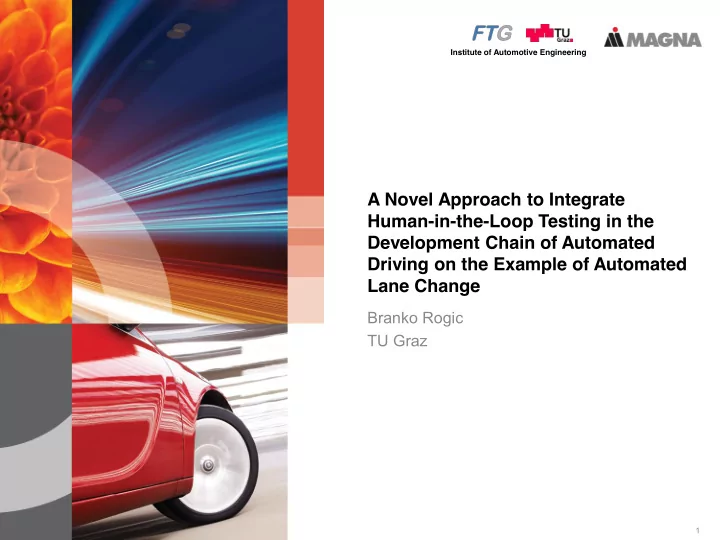

Institute of Automotive Engineering A Novel Approach to Integrate Human-in-the-Loop Testing in the Development Chain of Automated Driving on the Example of Automated Lane Change Branko Rogic TU Graz 1
Agenda Institute of Automotive Engineering • Project Introduction • Automated Driving System Development Chain • Automated Lane Change Function & HMI Concept • Human-in-the-Loop Testing with Driving Simulator • Results & Discussion 2
Project Introduction Institute of Automotive Engineering • Project goal: implementation of virtual tools in the development process of automated driving systems • The automated lane change (LC) function is used for demonstration purposes as system under test • Industrial project in cooperation with Magna Steyr Double V-Model for the development of Advanced Driver Assistance Systems (ADAS) 3
Automated Driving Function (ADF) Development Chain Institute of Automotive Engineering Functional concept Survey on driver impressions over tested ADF HMI System (Validation) modeling design Development test- ADSG Tests with scenarios multiple test drivers Benchmark & human driver recording tests System ADSG adaption & parametrisation ADF implementation ADSG – Automated Driving Simulator Graz 4
Automated Lane Change Function & HMI Concept Institute of Automotive Engineering • Lane change algorithm for decision making and trajectory planning based on dynamic traffic (Samiee, 2016) • Parametrisation based on recorded natural test drives with multiple drivers • HMI concept (Quinz, 2017) Manual mode Semi Automated mode Automated mode 5
Human-in-the-Loop Testing Institute of Automotive Engineering Driving Simulator Study • Stationary driving simulator with full vehicle body, 360 ° surrounding view, acoustic and force-feedback simulation • 20 test persons Method • Two-way test concepts: fixed manoeuvres and traffic Front view flow scenario • The fixed maneuvers evaluate driver acceptance with respect to the lane change starting point and its duration (focus function) Side view • The traffic flow test concept gives feedback about overall driver impression regarding usability and user friendliness (focus HMI) Rear view 6
Fixed Manoeuvres Institute of Automotive Engineering • Four repeatable standard manoeuvres with fixed kinematic for all vehicles • Every manoeuvre was driven three times by each test person: Manoeuvre 1 • Manual • Automated variant 1 • Automated variant 2 • Questionnaire after each automated drive Manoeuvre 2 regarding: • Overall performance impression • LC initiation timing • LC duration Manoeuvre 3 Manoeuvre 4 7
Traffic Flow Scenario Institute of Automotive Engineering • Microscopic traffic flow simulation of a three-way highway with calibrated parameters from road measurements (PTV VISSIM) • Simulated driving in “naturalistic” highway traffic • Feedback about the overall driver impression of the LCA system • Focus on HMI • Three LCA modes: • Manual • Semi Automated • Automated • Two-way questionnaire: • NASA Task Load Index • Specific questions regarding system understanding, safety and complexity and driving comfort 8
Fixed Manoeuvre Study Results Institute of Automotive Engineering Initialisation timing [s] LC duration [s] Mean value +/- standard deviation (N=20) 16,1 +/- 9,0 8,3 +/- 4,1 Mean value exl. outliers +/- standard deviation 11,1 +/- 2,8 (N=14, <15s ) 6,7 +/- 1,9 (N=15, <9s) • Initiation timing (calculated over TTC) for most drivers under 15 s • LC duration normally under 9 s • No correlation between manual driving behaviour and rating of automated driving performance � “Driver vs. Passenger” 9
Fixed Manoeuvre Study Results Institute of Automotive Engineering best rate 7 worst rate 1 10
Fixed Manoeuvre Study Results Institute of Automotive Engineering best rate 7 worst rate 1 11
Fixed Manoeuvre Study Results Institute of Automotive Engineering best rate 7 worst rate 1 12
Traffic Flow Scenario Results Institute of Automotive Engineering NASA Task Load Index (TLX) “…subjective , multidimensional assessment tool that rates perceived workload in order to assess a task or other aspects of performance” [Wikipedia] • The questions were adjusted according to the driving task and different LCA modes in highway traffic 13
Traffic Flow Scenario Results Institute of Automotive Engineering • Specific questions regarding system understanding, safety and complexity and driving comfort totally disagree 1 totally agree 7 14
Institute of Automotive Engineering Thank you for your attention 15
References Institute of Automotive Engineering S. Samiee, A. Shahram, K. Reza and A. Eichberger, "Towards a Decision Making Algorithm for Automatic Lane Change Maneuver Considering Traffic Dynamics", Promet - Traffic and Transportation, vol. 28, 2016. 16
Recommend
More recommend